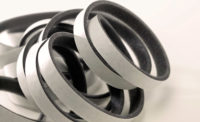As the marketplace for consumer electronics devices becomes more sophisticated, the adhesive products that hold them together have to be just as versatile and multifunctional. Consumers have demanded their devices get sleeker, more powerful, and lighter, putting demands on manufacturers. Filling that demand asks for more from the adhesive that literally holds the product together.
Pressure-sensitive adhesives (PSAs) are up to the challenge. When it comes to PSA tapes for mobile applications like phones or tablets, the challenge is in not only delivering a tape that will act like a tape, but one that also works with a touch-sensitive screen. That same tape also has to deliver protection against falls and drops, or drops of water. In addition, laptop manufacturers demand a tape that holds a screen to its backing, but must also be removable so technicians can get inside and make repairs or replace the screen altogether.
Getting the Call in Mobile
As developers and manufacturers of mobile electronic devices push for lighter and smaller models, PSA manufacturers are hustling to turn out products that meet those demands. In the mobile phone segment, the trend is toward sleeker, lighter units. This means that PSA manufacturers must first consult with engineers to discuss measurements: How thick a device is, whether its overall shape has changed, and how much room there will be for a tape that still needs to hold the overall structure together. While the available real estate inside mobile devices gets smaller every year, tablets still offer a larger workspace and the space requirements may not be as much of a concern.
The mobile segment also offers additional requirements for PSA manufacturers. Today, original equipment manufacturers (OEMs) are in need of waterproofing, with polyethylene and acrylic foam tapes providing the seal that is resistant to impact and heat while still holding a phone together. This adhesive must also be able to play other important roles, including the ability to receive feedback from tapping fingers. All this durability and functionality also needs to be packed into a thin tape that is between 150-400 microns.
With most mobile devices, the need for PSAs is most common in lens bonding. However, the areas of sound and vibration damping are increasingly requiring new innovations, sometimes granular in scale. Adhesive specialists are answering demands for shock absorption in these devices, where the challenges are more intense based on their on-the-go use. That is why phone tape products are meant to be permanent as well as impact resistant. Engineers measure an adhesive’s reaction to offenses like drops, as well as how well the tape absorbs that shock and dissipates it through the system.
Laptops: Quiet But Quirky
Laptops have additional demands that present new requirements for PSA manufacturers. For example, tapes need to have a damping effect on keypads to reduce the noise generated by key strikes. (The worst culprit on most keyboards: the space bar.) Typically, the more expensive the device, the higher the expectation of noise reduction.
The vibrations that generate noise also occur on devices with touchpads; customers have developed an expectation that their touchpads are quiet, meaning more vibrations will need dampening. The same goes for internal fans that keep laptops from overheating; once again, the right adhesive must be used. To add further complication, there’s not just one solution; engineers work with OEMs to gauge just what temperature and frequency range they are seeking from their fans.
Bezel bonding is another area where PSAs play a vital role. In most laptop or tabletop constructions, the bezel is the backing of the laptop screen. The tape is used to hold the screen to the bezel. Unlike some applications, laptop repair operations need to remove the bezel so they can fix or replace the screen.
Adhesive products in this area must feature dynamic constructions that are strong and removable when needed. The double-coated tapes used cannot be equally strong on both sides; one side will need to be strong enough to affix the screen but then yield when a technician needs to remove the screen.
Test, Change, Test Again
None of the beneficial qualities of PSA products are happenstance. Before a PSA tape ever gets into the hands of device manufacturers, adhesive product engineers subject them to a battery of tests designed to anticipate results and challenges. Tests range from carefully measured, orchestrated tests to real-world durability tests. Engineers are looking to see how well their adhesive tapes handle heat, cold, humidity, water pressure, and impact. In other words, they know better than most just how far a phone will need to fall before the impact of landing breaks it into pieces.
Waterproofing tests, for example, work against two standards: IPX7 and IPX8. The first, IPX7, is a pass-fail test that means a device can be submerged in water at a depth of 1 meter for 30 min without failing. A successful test tells observers that no water has gone through the tape. The second test, IPX8, ups the ante on time and depth: a device is submerged in water for more than 30 min and a depth of over 1 meter.
Other tests are more intuitive. One common practice is to drop a phone to measure its impact resistance. Other tests get physical, to see whether a tape provides the right adhesion. For example, engineers might put a suction cup on the back glass, then pull to test if the bond survives.
Other real-world tests include those for heat tolerance. This can be done by running prototypes in heat and humidity chambers. Following testing standards, the heat of different regions in the world can be simulated by leaving a prototype device in a car that has been parked under direct sun.
Serving the Evolving Marketplace
Anyone who has owned a leading mobile device knows they are watching a product become out of date before their very eyes. Just as you think you have the latest, lightest, and slimmest mobile phone design, the company offers something better. Mobile electronics designs can change as frequently as every six months.
Though this might be frustrating to the consumer, the designers of PSA tapes have their own challenges. As a device changes shape or gets smaller, the tape producers typically meet and consult with the OEMs’ design teams to help them anticipate the size and shape of a new device’s dimensions and to see if the tape they provided for a previous device iteration will work. The answer, more often than not, is “No.” The process of measuring, building, testing, and releasing begins anew.
The stakes for tapes in mobile applications are high, whether for phones, tablets, or laptops. Consumers, of course, benefit from all of this careful consideration and planning. The end of innovation is nowhere in sight, as long as the market continues to demand the development of better, lighter, slimmer devices. As a result, PSA tape engineers can continue to expect visits from device makers bearing prototypes, asking yet again for a tape designed to hold their new product together under duress and trouble—whether real, contrived, or just imagined.
For more information, visit https://tapes.averydennison.com.







